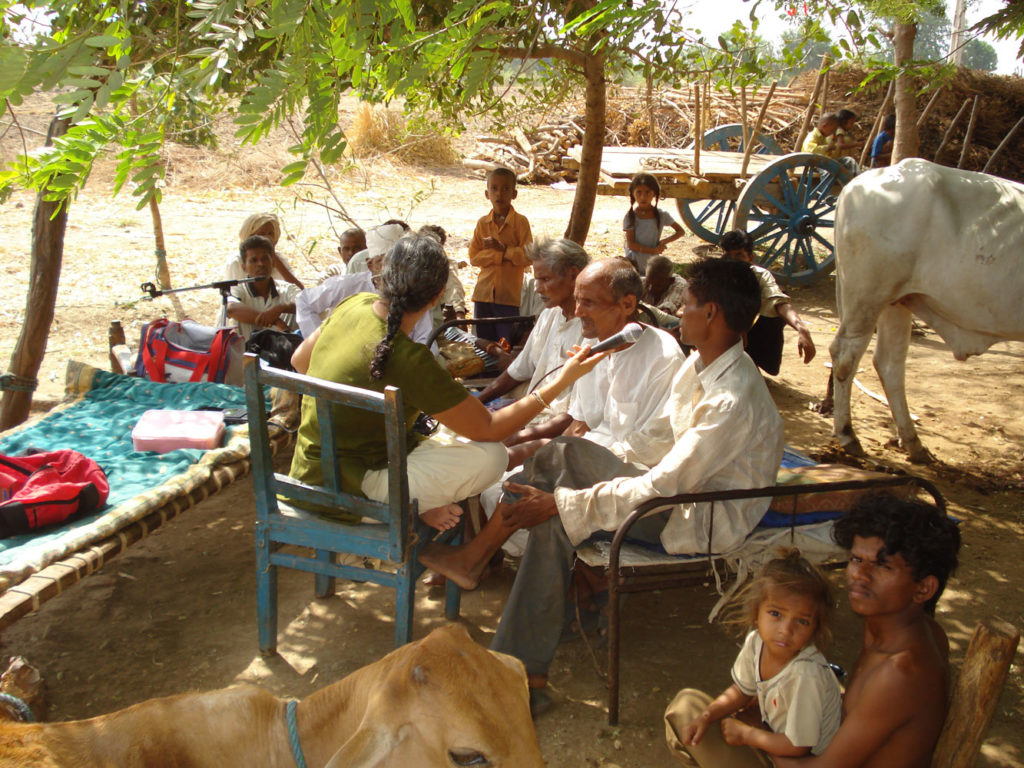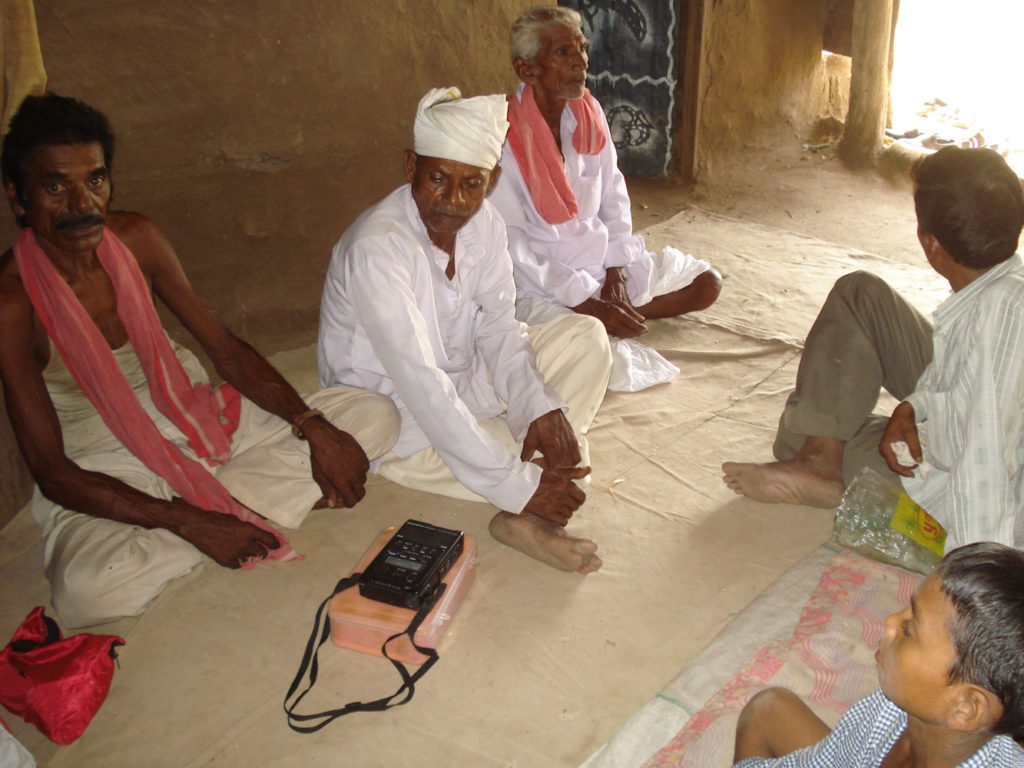Nandini Oza has been an activist of the Narmada Bachao Andolan (NBA) for over twelve years, and then a resident of the Narmada valley maintaining close connections with the movement for another nine. Nandini Oza began recording the oral histories of prominent leaders and activists of the NBA, both local and from outside the Narmada valley, of men and women belonging to adivasi, farming and other natural resource dependent communities in 2004.

Over a period of nearly 2 decades, beginning 2004, I (Nandini Oza) recorded in digital format eighty interviews of senior members of the NBA in seven different languages and dialects (English, Hindi, Gujarati, Marathi, Nimadi, Pawari and Bhilali). The selection of interviewees was done collectively with other activists and members of NBA support group. The selection has been with the twin objectives of recording interviews of key players of the struggle, at the same time focussing on those who are less known and are less likely to write the history themselves.
During the period of nearly 20 years, some of these interviewees have been interviewed twice or even thrice to capture the longer span of events and history. The interviews are anywhere between one to ten hours long, occasionally even longer. Some interviews of the local Adivasi leaders of the NBA have been taken soon after their displacement and then again many years after their displacement. This was to get a better idea of the changing life of the people as a result of development induced forced displacement. For example, the senior Adivasi women leader of NBA, Champaben Tadvi was interviewed in 2009, 13 after she was displaced from her village Vadgam on the banks of the River Narmada in 1994. Champaben was interviewed once again in the year 2023, over 28 years since her displacement from Vadgam. So was Ushaben Tadvi displaced in the year 1994 was interviewed in 2009 and once again in 2023. Both these interviwes are available here on the website.
Having been an activist of the NBA, I have had an added advantage of the trust and faith of the people interviewed for such an oral history collection. As the key figures of the Narmada struggle felt in equal measure the need and urgency for such an archive, the interviewees have come forth and have lain bare what they have wanted to say. The oral history that has emerged is therefore in the nature of free conversations and in-depth sharing of people’s work, views and thoughts. It presents a record of the history of the Narmada struggle spanning over several decades in the voices of the people themselves. More importantly, as the interviewees could talk in the comforts of their own homes, in their mother tongue or the language they were comfortable in, with a person they had worked with, the information that people have shared is special.
As a wide range of people, with different roles and experiences, falling in three different States, with varied cultural, political and social backgrounds have been interviewed, the history so collected is diverse.

I must also indicate that such an oral history has its limitations, and I recognize these. Some limitations are inherent to the methodology of oral history itself. Others are more due to the specific circumstances in which I have carried out these recordings.
Some limitations intrinsic to the oral history methodology are fading of memory of individuals over the years and personal biases of historians.
Some limitations are specific to this work. For example, adivasi people even in these changing times believe that talking of their own role and contribution to the struggle, however significant, is like blowing one’s own trumpet. People were therefore reluctant to talk about themselves till pursued but were happy to talk about events, issues and role of others as they saw it. Another problem was that while people shared freely many a sensitive issue and critical assessments of the shortcomings of the struggle and its strategies, and much of this has been articulated on record, some of the very sensitive information concerning the movement was narrated off the record. Therefore the narrations of some of the significant issues of the Narmada struggle remain only in my memory and my private notes.
Then of course my personal limitations, expertise or lack of it has to be accounted for. Although practised in Indian society, oral history is a new discipline in India, not yet fully accepted as “legitimate history”. The Oral History Association of India is still in its nascent stage and there are only a few courses available teaching oral history in India. Although things are changing and there is better acceptance of the discipline, there were no courses or trainings in oral history in the country when I started out. Therefore this is an outcome of self-education and learning from material and books available on the subject back then and getting better along the way.
Another issue I faced was the constraint of time and resources. NBA being a political movement, I was careful of the source of funds for this work and did not want it to be a large funded project. I have therefore not been able to record all the important players of the struggle. Some interviews got left out due to other unavoidable circumstances too. For example some of the people I wished to interview did not give an appointment or fix a date in spite of repeated reminders including Medha Patkar, Anil Patel, Pratibha Shinde, etc. However interviews of the prominent faces involved in the Narmada issue are easily available at multiple places including books and magazines. Therefore in the oral history here, care has been taken to record most of the key players who have not been written about in detail or have not shared their views themselves or are unlikely to do so in the future. Some of the interviews are incomplete which I will be completing soon.
My own long involvement in the struggle, and my personal relationships with those interviewed, while an immense advantage in many ways for these recordings, may also be considered a limitation in some ways. Such closeness to the subject of discussion and with the persons interviewed may not be considered as dispassionate.
Having outlined the limitations, I also wish to say that every form of recording and documenting history has its own problems. Such limitations by themselves do not detract from the importance and significance of the particular approach and the history so recorded, so long as we recognize them.
I have tried to be conscious of the limitations while doing these recordings, and have attempted to address them where possible.
One important issue I wish to share here is about translations. As the interviews recorded are in 7 different languages and dialects, translating these have not been an easy task. While I speak three of the languages and understand almost all reasonably well, I am not an expert in languages. I have therefore taken help for translations of some interviews into English and Hindi. And while I have personally gone through each word that has been translated even from Pawari and Bhilali, languages that do not have a written script, there is always scope for improvement. Any suggestions for change in the translations of some words in the interviews are welcome.
This is an on going work and I will be putting up more interviews here that have not yet been shared as per the availability of time and resources.
I believe that the oral histories that have been so recorded and shared here
are greatly valuable as they bring out voices that are powerful, authentic and diverse, voices of people who have actually participated in making history in the Narmada valley.